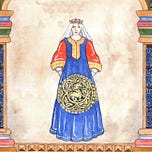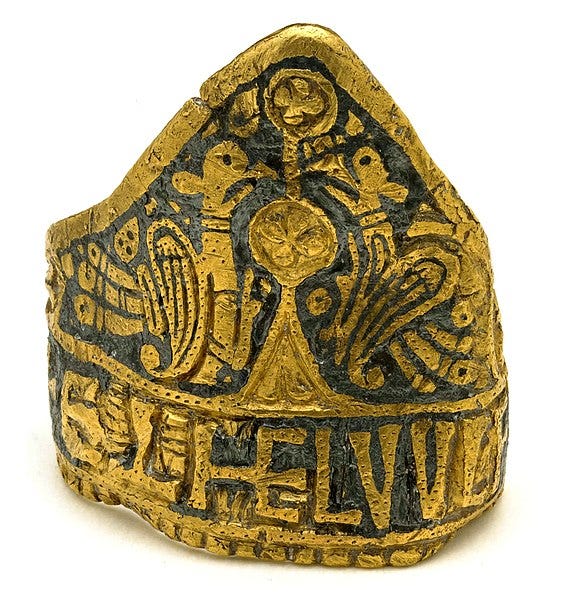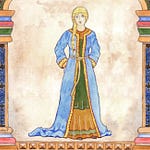Ælfgif-who? provides short biographies of early medieval English women. Click on the podcast player if you’d like to hear this newsletter read aloud in my appealing Yorkshire accent.

Æthelswith: The Mercian queen whose gold ring was unearthed by a Victorian ploughman
Florence H R Scott
In 1870, a man was ploughing a field in West Yorkshire, in the countryside between the towns of Aberford and Sherburn on Elmet. As his plough overturned a row of soil, he glanced a glimmer of gold. He halted his horses, and bent down to pick up the shiny object, freshly unearthed. It was a large, gold ring, with an intricate enamelled design of a lamb of God on the outside, and an inscription that read ‘EADELSVID REGNA’ on the inside. The ploughman took it home with him, and fixed it to his dog’s collar.
A few years later in 1873, the ring was sold to a jeweller in York, and identified as around a thousand years old. It was purchased by an archeologist and collector of antiquities called William Greenwell for £30 (around £2700 in today’s money). In 1897 this invaluable treasure was passed into the collections of the British Museum, where it remains to this day.
There is no record of how much the anonymous ploughman was compensated, nor if he even was aware of the provenance of what he had discovered - nevertheless it was due to his toil and his careful eye that this beautiful historical artefact resurfaced.
But what of the ring’s original owner? The interior inscription reveals that this ring once belonged to a Queen Æthelswith. Its age and the location in which it was found both strongly suggest that it belonged to the Æthelswith who was the sister of King Alfred, and married King Burgred of Mercia in 853.
Rings were associated with royalty in this period. A ring was bestowed upon the king and queen in near-contemporary coronation ceremonies. Another inscribed decorative ring has survived from this period, which belonged to Æthelswith’s father King Æthelwulf. These rings share similar designs, materials and artistic techniques.
However, it has been noted that Æthelswith’s ring is very large in diameter. It was likely not worn by the queen herself, but inscribed with her name and bestowed upon a loyal subject as a gift, or as a symbol of an official title or office.
That Æthelswith was the bestower of such gifts is consistent with the other things we know about her. In 868 she witnessed a West-Saxon charter, in which she made a grant of fifteen hides of her own land in Berkshire. She also witnessed all of her husband King Burgred’s charters. Though we only see glimpses of her influence, Æthelswith, like other Mercian queens before her, was a politician.
It is not known when this ring was lost by its wearer - it may have been lying in a West-Yorkshire field for a thousand years before it was discovered. But while the ring clearly remained in England, its bestower did not.
In 874, twenty one years after Æthelswith married Burgred, the royal couple were forced out of their kingdom by an encroaching Viking army. They fled together to safety in Rome. While Burgred died soon after they arrived, Æthelswith outlived him for another decade, which she spent in Italy.
Queen Æthelswith passed away in 888 in Pavia, and was laid to rest there. She may have been undertaking a pilgrimage when she died. Her body and the ring that she once bestowed were both buried underground a thousand miles apart. And they say medieval women didn’t travel…














Share this post